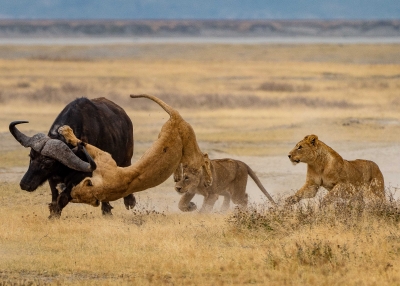
Lions live in prides of anywhere between 3 to 30 beasts. The females, usually all related, stay with the pride for life. Male lions usually leave when they get to about two years of age. It is the females that select and stalk the prey, then make the short dash to pounce and kill it. However, it is the biggest male who will eat first.
What, Where and When
The choice of animals that the lion hunts for food is largely dependent on what sort of food is available in their particular area of habitation. Generally, the scrub country which lions tend to favour more than anywhere else, provides them with many different kinds of herbivores. Their favourites are wildebeest, zebras, antelopes, gazelles and waterbuck. They do though, also have a fondness for warthogs and have been to know lie in wait outside their burrows for hours on end. However, if a lion is hungry enough and cannot find its preferred food it’ll resort to eating whatever it can find, including fish. They also target other large animals such as buffaloes and giraffes, though they do so with great difficulty and with enormous risk to their own lives. Indeed, many lions injure themselves when they try to control bigger animals. It’s not uncommon after such an encounter for an injured lion to be unable to partake in any future hunts.
Most hunting done by lions is under the cover of darkness; in the gloom of an African night they can easily observe and stalk their prey without the threat of detection. It’s actually quite common for lions to sit and observe their prey during daylight hours, usually just before sunset. But they mostly wait until after dark before launching an attack. Similarly, if the landscape is illuminated by bright moonlight, then they’ll wait until it’s obscured before attempting any sort of hunt. The main reason why they do this is simply because their typical habitation is devoid of cover. Often in the daytime, a lion will begin closing in on a potential victim, but will subsequently give itself away, resulting in the prey escaping easily. Lions that live in areas with thicker cover are able to do more of the hunting in daylight hours. Other hunting that occurs in sunlight is directly related to the activity of a particular prey species. For example, when zebras or gazelles drink from lakes or rivers during the heat of the day, their presence often produces a flurry of hunting. But usually, most stalking by lions is done just after sunset, or during the middle of the night, several hours before dawn.
Senses and Deficiencies
More than anything, lions rely on their sight to help them with hunting. Experts have observed individuals stalking under vegetative cover, occasionally sticking their heads up high out of their cover in order to keep track of a particular animal they may be stalking. In the process though, they do sometimes give themselves away inadvertently.
Lions occasionally detect their prey through hearing. They frequently react to the sounds of animals walking or moving through water and set out to investigate. There have also been examples of lions utilising their sense of smell to aid in the hunting process. But generally, lions hunt only what they can see, and are thus not particularly adept at detecting prey in the same way wolves are for example. It’s quite normal for a large group of herbivores to pass right by a pride during the day, due to the fact that the lions normally use daylight hours to snooze.
Working as a Team
Another, or to put it more accurately the most important reason that lions are able to find enough food is that they usually do their hunting cooperatively. They will stalk their victims for up to an hour, but fifteen minutes is more the norm before deciding to pounce. Normally, several lions circle around the herd they are attacking, slowly driving their victims towards some of their fellows hiding in tall grass. These lions, usually females also known as lionesses then attack their prey from the sides or the rear. Cooperative hunting also makes up for another significant problem that lions have in comparison with other predators, their lack of speed. By our standards of course, these mighty creatures are anything but slow, their top seed is around 30mph, but they can only sustain it for around a minute. Indeed, they rarely pursue a prey item for more than 100 yards. By working in groups they are able to tackle prey that would otherwise prove too fast or elusive for them.
Lions also gain another advantage through group hunting when they have killed an animal too large for one to eat alone; with an entire pride partaking in the consumption of food not only does more food go to more mouths at one time, but it also allows the pride to avoid the problem of having to guard or store their food. Such problems are frequently encountered and dealt with by other big cats such as leopards and tigers, who often find ingenious ways of hiding their kills from competitors. Leopards, for example often stash their kills in a tree while tigers will remain in the vicinity of their kill until it’s fully eaten. Lions, being denizens of open country simply don’t have the luxury of being able to hide or shelter the food.
Credit : Owlcation.com
Picture Credit : Google

